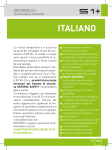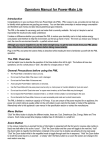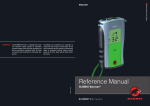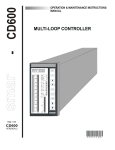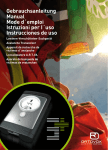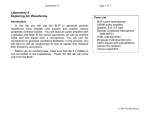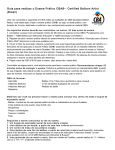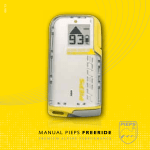Download 2009 Transceiver Test Assessing the new Three Antenna
Transcript
2009 Transceiver Test Assessing the new Three Antenna Transceivers F. M. Swangard MD1, Bob Sayer2, Steve Gunderson3 Abstract There has been a great deal of change since the last transceiver test which the Canadian Ski Patrol presented in 1999.4 Transceivers have changed in their technical construction and as a result of these changes there has been a profound change in how they are used. A number of extra features have been added which may improve finding a buried person. We tested the most common five new transceivers used in British Columbia against the Ortovox F1, an older, single antenna transceiver, which is most commonly used in British Columbia. We first tested the transceivers with fifteen certified ski guides who in their workplace used the Ortovox F1. Each guide used all six transceivers in a simulated avalanche.5. The times to find the two buried transmitters were recorded. We then performed the same program with fifteen high school students who had never used transceivers. We staged it so that the novice high school students were divided into three groups, each of which used the transceivers in a different sequence to rule out a learning advantage by using the transceivers in the same order. The results showed only a small difference in the times of the guides using the new models, with the Ortovox d3 being the fastest and the F1 the slowest even though the F1 is the transceiver they used most often. The results with the students were most interesting. Only four out of ten (two of the three groups) were able to find the second buried transmitter within the seven minute time limit using the Ortovox F1. All students were able to find all the targets with their new model transceivers in their test group. The fastest times were with the Ortovox S1which was slightly faster than the Ortovox d3, Mammut Pulse, Tracker DTS, and the Pieps DSP which finished in that order and quite close together. Clearly the new transceivers are much better in the hands of a novice or irregular user. Key Words: Avalanche; Transceiver; Avalanche Beacon; Ortovox; Mammut; Pieps; Tracker. 1 Canadian Ski Patrol System Life Member, Canadian Delegate to the International commission of Alpine Rescue. 2 President of the Canadian Ski Guide Association, Associate Delegate to the International commission of Alpine Rescue. 3 Member and Board Member Canadian Ski Patrol System, Greater Vancouver Zone and Avalanche training officer for B.C. 4 Canadian Ski Patrol System (CSPS) Transceiver Test 1999 presented at IKAR. 5 Training material taken from the user manual of each Transceiver. CSPS and CSGA Transceiver Test 2009 Introduction There are a number of types of equipment which may help if a person is involved with an Avalanche but none replaces a transceiver. Clearly, the minimal safety equipment a person must have in the back country, in winter, is a transceiver, a probe and a shovel. A person should be prepared to overnight even if it is not planned. The shortest time taken to extricate a buried person the better his chances of survival. The chances of a live rescue fall quickly after fifteen minutes.6 In the winter of 2008-2009, 24 persons died in avalanches in Canada with 144 deaths over the last 10 years and British Columbia had the largest number of fatalities.7 The best way to avoid being involved with an avalanche is to stay away from them. Check first with the Canadian Avalanche Centre (CAC) at <www.avalanche.ca> or your regional avalanche information service as to the avalanche danger level and if it is high don't go in to avalanche terrain. When going into a park area, check with the rangers office as to the risk of avalanches and file a trip plan. Make sure every person in your group knows how to use their transceiver and agree on a rescue plan. Know how to check the snow conditions as you travel along your route. Materials and Methods We received four transceivers from Mammut (pulse) and Pieps (DSP). Mountain Equipment Coop loaned us four Tracker DTS. Ortovox sent us four d3's and four S1's. We borrowed four Ortovox F1 transceivers from the Canadian Ski Patrol System, Greater Vancouver Zone. We also borrowed the Ortovox remote-controlled test system (five transmitters which can be remotely turned on and off) from Mike Wiegele Heli Ski Resort at Blue River. The first session took place at Mike Wiegele Heli Ski Resort in Blue River, British Columbia, using the heli-ski guides as knowledgeable testers. These guides and their clients use the Ortovox F1. We created a simulated avalanche thirty by fifty metres in size and buried the transmitters across the run-out area. The transceiver manufacture’s instructions for use of each transceiver was given to each tester prior to using each transceiver. We, randomly turned on two of the five Ortovox transmitters then let each tester (guide) enter at the top end of the “Avalanche” to start a search grid until a signal was received, at which time they were to follow the instructions from the applicable transceiver manufacture. The time was measured from the entry until finding the second transmitter. Two different test transmitters were switched on for every test. The results are shown in Appendix 1. 6 Time Is Life Video from The International Commission of Alpine Rescue (www.IKAR-CISA.org) 7 Canadian Avalanche Centre (www.avalanche.ca) CSPS and CSGA Transceiver Test 2009 The second session took place at Hemlock Resort just east of Mission, British Columbia. We created a simulated avalanche thirty by fifty metres in size and buried the five Ortovox test transmitters across the run-out area at the base of the “Avalanche”. The fifteen students were divided into three groups and each group had a different sequence of transceivers to test to remove a learning effect where-by the use of first transceivers could lead to improved times with the later transceivers. Using the transceiver manufactures instructions, the groups were given a thirty minute instruction course with practice prior to the testing of each transceiver. Two of the five test transmitters were switched on and each novice tester was started at the top of the “avalanche”, where a normal search pattern was followed until a signal was received, at which time the instructions from the applicable transceiver were followed. The time was measured from “avalanche” entry to marking of the second transmitter. Two different test transmitters were switched on for every test. A time limit of seven minutes was set to find the second transmitter. If this was not achieved the test was declared as “not found”. The results are shown in Appendix 2. Results In the hands of a knowledgeable user there was only a small difference in search times between the two-antenna and the newer three-antenna transceivers. The fastest was the Ortovox d3 (avg 1 minute 13 sec), then the Tracker (1minute 35 sec), the Pieps (1 minute 36 sec), the Ortovox S1 (1 minute 38 sec) and the Mammut (1 minute 47 sec). The slowest was the Ortovox F1 (at a still respectable 1 minute 56 sec). The standard deviation (STDEV) shows how much variation there was in the times and a low number suggests a more consistent ease of use, ranging from the Ortovox S1 at :23, Ortovox d3 at :31, Tracker at :32, Pieps at :36, Mammut at :47, and the Ortovox F1 at 1:07. In the hands of an expert user there appears to be little difference in the results using the multi-antenna transceivers and all are faster than the F1 which is nearing two decades of use. The results from the naive users are very interesting! Six out ten testers failed to find the two targets using the Ortovox F1 in the allotted time. All the naive users did much better using the two and three-antenna transceivers. The fastest was the Ortovox S1 (2 minutes 59sec), the Ortovox d3 (3 minutes 21 sec), Mammut (3 minutes 25 sec), the Tracker (3 minutes 26 sec,) and the Pieps (3 minutes 34 sec). Discussion Both the guides and naive users liked the ease of use and the marking of multiple burials on the screen of the Ortovox S1. The screen of the Ortovox S1 did not seem to be affected by by the cold ( at times -15C to -20C). The Ortovox d3 was very easy to use but not as easy to find multiple burials as the S1. Both the Ortovox model S1 and d3 also had the best attachment systems. The Mammut Pulse worked well when correctly set up. It seemed to have too many parameters to set and really needs a lock function to stop a desired setting from being CSPS and CSGA Transceiver Test 2009 changed. The authors also feel that the “Pulse” feature should not be used on ethical grounds because of questionable reliability. The attachment system is good. The Pieps DSP worked well but the on-off slider switch which sticks out from the transceiver seemed to present a risk of being easly broken. We also found the deactivation of the transceiver with the special probe presents a risk of abandonment of the buried person if the transceiver is turned off and the probe were to be removed by a person not knowing what had been done. We would advise not to use this feature. The attachment system was not as easy to use as the others. The Tracker DTS did better than we expected as a two-antenna transceiver being compared to three-antenna models. The pinpointing with this transceiver was more difficult than with a three-antenna transceiver. The authors expect this company will update their transceiver in the near future. When this is done we recommend that they also update their attachment system, which was determined to be the poorest. Conclusions Any transceiver is better than none! The new three-antenna transceivers are faster in finding a buried person in an avalanche than the older single antenna transceiver. This is especially true for the naive user. Guides or guiding companies using anything other than three-antenna transceivers should consider upgrading. The simpler the transceiver is to use the better. Extra functions such as the pulse detection with the Mammut and the probe switch with the Pieps may have serious ethical problems and detract from the primary goal -”Find and rescue the buried person”-. The “Test Box” from Ortovox for the Ortovox S1 appears to be a very good way to assure full function of each S1 transceiver prior to its use. This will be especially useful for larger operations such as heli and snow cat companies and rescue organizations. Disclosures This study was not supported financially or materially by any of the transceiver manufacturers whose equipment was used in this study. The authors, Swangard, Sayer and Gunderson have no financial ties or conflict to disclose. We would like to thank Ortovox, Mammut, Pieps and Mountain Equipment Coop for loaning us the transceivers. We would also like to thank Mike Wiegele Helicopter Ski Resort and Hemlock Ski Resort for providing us with staff and mechanical support. Thanks also to the Canadian Ski Patrol System, Greater Vancouver Zone which provided testing, training and support without which we could not have completed this program. We would also like to thank the Mennonite Educational Institute (a high school in Abbotsford British Columbia) and the 15 wonderful (naïve) test subjects who volunteered for this study. CSPS and CSGA Transceiver Test 2009 Appendix 1 CSPS and CSGA Transceiver Test 2009 Appendix 2. CSPS and CSGA Transceiver Test 2009 Appendix 3. Avalanche Statistics for Canada Used with permission of the Canadian Avalanche Centre. (CAC) www.avalanche.ca











